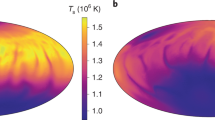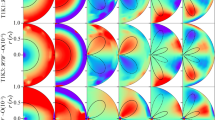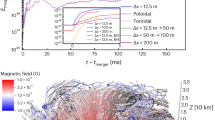Abstract
The recently discovered1,2 1.5-ms pulsed radio source PSR1937+214 could be close to the onset of rotational instabilities if it is envisaged to be a rotating neutron star which gives interesting lower limits for neutron star masses. We examine here the implications of polar gap models for such a rapidly rotating magnetic neutron star. It appears, on the basis of such models, that a higher fraction of high-frequency microwave radiation compared with the Crab pulsar is an expected result. On the other hand, the outer gap discharge models invoked for longer period pulsars yield a large amount of high-energy radiation which is not observed. The high-energy cutoff in the γ-ray region evaluated from assumed values of the magnetic field inside the light cylinder will be around 1,000 GeV.
This is a preview of subscription content, access via your institution
Access options
Subscribe to this journal
Receive 51 print issues and online access
$199.00 per year
only $3.90 per issue
Buy this article
- Purchase on Springer Link
- Instant access to full article PDF
Prices may be subject to local taxes which are calculated during checkout
Similar content being viewed by others
References
Heiles, C. et al. Nature 300, 399 (1982).
Backer, D. C., Kulkarni, S. R., Heiles, C., Goss, W. M. & Davis, M. M. Nature 300, 615–618 (1982).
Radhakrishnan, V. & Srinivasan, G. Curr. Sci. 51, 1096–1099 (1982).
Alpar, M. A. et al. Nature 300, 728–729 (1982).
Henrichs, H. F. & vanden Heuvel, E. P. J. preprint (University of Amsterdam, 1983).
Bodenheimer, P. & Ostriker, J. P. Astrophys. J. 180, 159–169 (1973).
Lindblom, L. & Detweiler, S. L. Astrophys. J. 211, 565–567 (1977).
Detweiler, S. L. & Lindblom, L. Astrophys. J. 213, 193–199 (1977).
Friedman, B. & Pandharipande, V. R. Nucl. Phys. A361, 502–520 (1981).
Pacini, F. Nature 216, 567–568 (1967).
Pacini, F. Nature 219, 145–146 (1968).
Ostriker, J. P. & Gunn, J. E. Astrophys. J. 157, 1395–1417 (1969).
Ashworth, M., Lyne, A. G. & Smith, F. G. Nature 301, 313–314 (1983).
Backer, D. C., Kulkarni, S. R. & Taylor, J. H. Nature 301, 314–315 (1983).
Ruderman, M. A. & Sutherland, P. G. Astrophys. J. 196, 51–72 (1975).
Ruderman, M. A., Pulsars, IAU Symp. No. 95, 254 (1981).
Cheng, A., Ruderman, M. A. & Sutherland, P. G. Astrophys. J. 203, 209–217 (1976).
Sturrock, P. A. Astrophys. J. 164, 529–556 (1971).
Author information
Authors and Affiliations
Rights and permissions
About this article
Cite this article
Ray, A., Chitre, S. Some characteristics of a rapidly rotating magnetized neutron star. Nature 303, 409–410 (1983). https://doi.org/10.1038/303409a0
Received:
Accepted:
Issue Date:
DOI: https://doi.org/10.1038/303409a0
This article is cited by
-
General relativistic effects on the pulse profile of fast pulsars
Nature (1985)
-
Models of rapidly rotating neutron stars
Nature (1984)
Comments
By submitting a comment you agree to abide by our Terms and Community Guidelines. If you find something abusive or that does not comply with our terms or guidelines please flag it as inappropriate.



